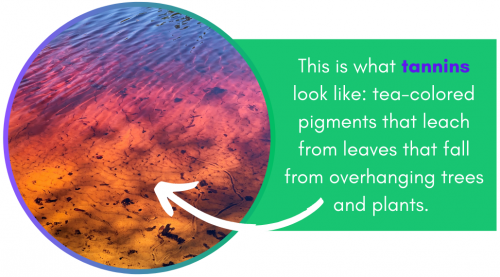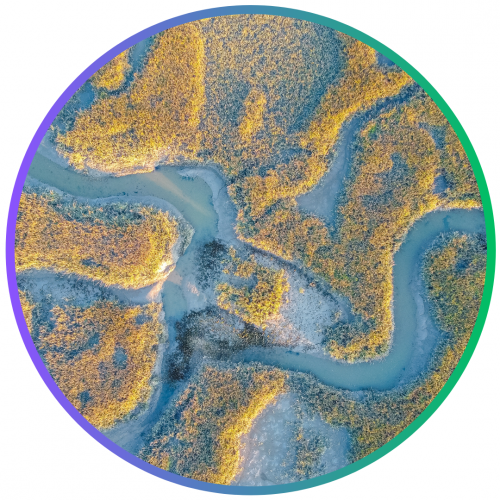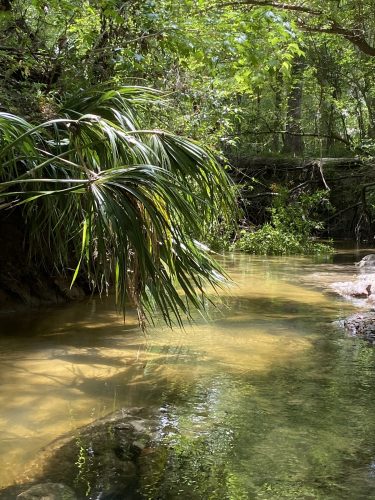Florida is home to over 1,700 rivers! They all provide unique habitats and support a range of different ecosystems. Not only are rivers important for the health of wildlife and vegetation, but they are gathering places for community and recreation and even affect the quality of our groundwater, which supplies our drinking water.
Types of Rivers
- Sandy-bottom: These streams are the most prevalent in the state, with slightly acidic water and moderate flow. These are the kinds of streams you are most likely to find in your backyard or neighborhood, or perhaps have even sifted through for shark teeth!

- Blackwater: Blackwater rivers have dark, acidic waters that are stained by organic matter and “tannins,” which are pigments that leach from organic matter. The Santa Fe River in northern Florida begins as a blackwater river before it reaches springheads that input clear, alkaline water.
- Alluvial: Alluvial rivers, such as the Apalachicola River, have large drainage areas and floodplains, and often open up into the Gulf of Mexico or Atlantic Ocean.
- Calcareous: Calcareous streams can originate from springs, where groundwater under pressure emerges at “vents” on the surface. Since springs are associated with highly porous limestone, calcareous streams can have a mix of limestone and sandy bottom.

- Coastal: Coastal rivers are highly influenced by tidal action, and can receive varying influxes of salty and brackish water depending on their proximity to marine waters. They can mitigate salinity in these habitats and support a wide range of species, such as seagrasses.
Why are Rivers Important?
Florida’s rivers help to:
- Distribute nutrients and sediments to wetland ecosystems.
- Support the growth of native plants and animals.
- Moderate salinity in brackish and estuarine waters, especially during times of high tide.
- And much, much more!
 The threatened Florida manatee, a keystone species, depends on warm river waters during the wintertime to forage and survive. Keystone species, also known as indicator species, are essential organisms that act like a glue for the whole ecosystem– without them, environmental systems would be far less resilient and interconnected. Manatees and their behaviors and individual health can help scientists to understand the health of the overarching ecosystem.
The threatened Florida manatee, a keystone species, depends on warm river waters during the wintertime to forage and survive. Keystone species, also known as indicator species, are essential organisms that act like a glue for the whole ecosystem– without them, environmental systems would be far less resilient and interconnected. Manatees and their behaviors and individual health can help scientists to understand the health of the overarching ecosystem.
What is the Problem?
Florida’s rivers, and by connection Florida’s wetlands, springs, and estuaries, are impacted by point source and nonpoint sources of pollution.
Point source pollution is a kind of direct contamination, such as wastewater flowing from a pipe. Nonpoint sources are more complex and contain a mix of pollutants that could include pesticides, fertilizers, motor oil, and chemicals leached from plastics. They enter waterways through runoff, drainage, or even through contaminated groundwater.
Rivers are also impacted by litter, which can impede flow and damage aquatic life, and invasive species that can outcompete native species.
What Can We Do?
To help keep Florida’s rivers and waterways clean for the well-being of the environment and ourselves, you can look for river cleanups in your area or you can organize one yourself!

Keep Florida Beautiful is an organization committed to reducing litter through volunteer-based initiatives, and has affiliates in counties throughout the state. You can look on their website to find a local affiliate near you and join a large river cleanup or invasive plant removal. If there aren’t any scheduled, you can also reach out to help organize one.
You can also take advantage of the beauty of Florida’s rivers by going canoeing, kayaking, tubing, or paddle boarding on a river near you and committing to collecting trash throughout the day. If you bring friends and family, you can even see who can collect the most litter on the river.
You don’t need to go canoeing or swimming to clean up rivers and streams—you can stick to the river banks where trash gets deposited or go to a small, shallow stream in your neighborhood and pick up litter there!
Information from UF IFAS, U.S. Forest Service, Florida Museum of Natural History, NOAA,
FWC, National Geographic, and Climate Adaptation Explorer. Images from Canva Pro.